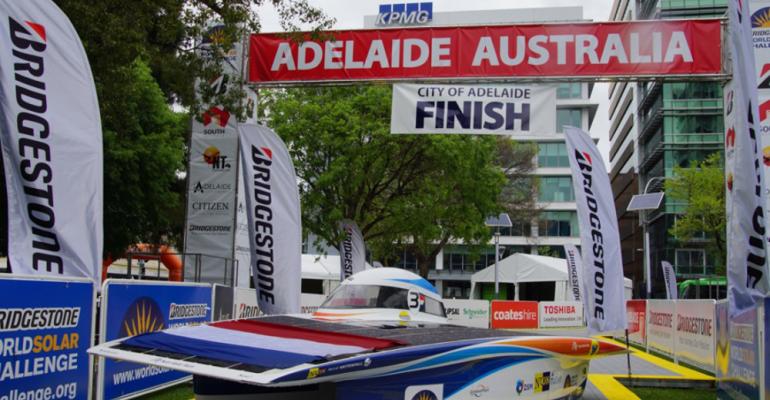The flying Dutch from Delft University in the Netherlands reclaim their title in the 2013 World Solar Challenge down the length of Australia.
The Nuon team took 33.05 hours to drive their car, Nuna 7, the 1,877 miles (3,021 km) from Darwin to Adelaide on solar power at an average speed of 56.35 mph (90.71 km/h).
It was Nuon's fifth win in seven starts in the event.
The Nuon team edged out defending champions Tokai Challenger from Japan's Tokai University, which won the last event two years ago with an average speed of 56.54 mph (90.99 km/h).
It was a close battle until the last 31 miles (50 km), and the two teams reached the final checkpoint in Port Augusta, 190 miles (306 km) north of Adelaide, just minutes apart. But then the clouds rolled in and torrential rain driven by gale-force headwinds followed.
Tokai Challenger was forced to stop and recharge its batteries, but Nuon continued along the course, thanks to energy from extra solar panels used while the car was stationary.
Solar Team Twente from the Netherlands finished third, ahead of California’s Stanford University team.
The fourth-place Luminos, designed by the student-run Stanford Solar Car Project, is a lightweight, teardrop-shaped car topped with solar panels that generate all the electricity it needs.
The Stanford team finished 11th in the race in 2011, in large part because the team attempted too many high-reward technological risks, which ultimately led to numerous glitches during the race.
The latest car represents two years of work and thousands of hours of designing, development and testing by the students, operating out of Stanford’s Volkswagen Automotive Innovation Laboratory.
The University of Michigan finished ninth after crashing and then repairing their car called Generation.
The Michiganders caught a strong gust of wind and crashed into a drainage ditch while in seventh place near the South Australia opal-mining town of Coober Pedy, about two-thirds of the way through the event.
“It’s not easy to see something you’ve worked on for a year and a half crash like that,” says Pavan Naik, the team’s business-development manager. “But we didn’t waste a minute. We rallied together and spent the night repairing the car.”
This year’s event saw a change in the rules to require all entries to have four wheels, and the University of Michigan’s Generation was the university’s first 4-wheeler.
It has the driver on one side, rather than in the middle of the chassis. The design allows for a sleeker underbelly and a more aerodynamic silhouette. The car weighs less than 600 lbs. (272 kg) and has a lithium-ion battery and carbon-fiber body.
The cars were allowed a nominal 5kW hours of stored energy for the race and all other energy came from the sun or kinetic energy from the vehicle.
The event started in Darwin with 38 teams from 22 countries, and first out of the starting gate was Team Eindhoven from the Netherlands and their world’s first family 4-seater, which won the time trial to determine the starting order.
The event is divided into categories. In the challenger class, where speed wins, at least 11 of the entrants failed to make it to the finish line.
The Cruiser Class requires entrants to meet road regulations in their home countries, and to seat at least two people. At last report it was being led by Powercore SunCruiser, built by the Hochschule Bochum Solar Car Team from Germany.
Team Eindhoven was in second with the University of New South Wales in third.
The only British team to qualify for the event, Cambridge University’s Eco Racing car Resolution, didn’t make it to the start after it crashed just days before the start.
Built by 60 students at the university's engineering department, the car was designed to run at an average speed of 50 mph (80 km/h). The team hoped to repair the damage, caused when the vehicle rolled on its side, skidded along the road and down an embankment, but finally withdrew from the event.
The diesel-powered Audi A3 Sportback successfully completed the course with an average speed of 60.89 mph (97.99 km/h), with the advanced 1.4 TFSI cylinder-on-demand engine delivering fuel economy of 50.04 mpg (4.7 L/100 km).
Audi was invited to participate in the event to illustrate how technology is migrating from the laboratory and the mobile test-bed to production cars for use in the real world.





